-
Paper Information
- Paper Submission
-
Journal Information
- About This Journal
- Editorial Board
- Current Issue
- Archive
- Author Guidelines
- Contact Us
American Journal of Intelligent Systems
p-ISSN: 2165-8978 e-ISSN: 2165-8994
2015; 5(1): 1-17
doi:10.5923/j.ajis.20150501.01
Knowledge Based Engineering: Notion, Approaches and Future Trends
E. Jayakiran Reddy 1, C. N. V. Sridhar 1, V. Pandu Rangadu 2
1Department of Mechanical Engineering, Annamacharya Institute of Technology and Sciences, Rajampet, Kadapa (Dist), A.P., India
2Department of Mechanical Engineering, JNTUA College of Engineering, Ananthapuramu, A.P., India
Correspondence to: E. Jayakiran Reddy , Department of Mechanical Engineering, Annamacharya Institute of Technology and Sciences, Rajampet, Kadapa (Dist), A.P., India.
| Email: |  |
Copyright © 2015 Scientific & Academic Publishing. All Rights Reserved.
Knowledge Based Engineering (KBE) is a research area for product design that involves complex and iterative processes based on methodologies and technologies for capture and reuse of product knowledge. Although KBE has been proposed to support product development for the last decade, it is still far to complete. As this is an attractive research area for the past decade many approaches are developed based on parametric, function based, web-based, case-based, ontology technologies for enhancing the capabilities of KBE. This paper is an effort to collect and review existing literature on KBE evolution, approaches and methodologies. The evolution of the KBE definition is also briefly discussed along with the current limitation and future trends of KBE. The objective of the review paper is to identify the foundation and research issues of KBE in the light of parametric, function based, web-oriented modeling.
Keywords: Knowledge Based System (KBS), Knowledge Based Engineering (KBE), Parametric Modeling, Function Based Modeling, Case-Based Reasoning (CBR), Web-based Design, Web-Oriented Modeling, Ontological Knowledge Base
Cite this paper: E. Jayakiran Reddy , C. N. V. Sridhar , V. Pandu Rangadu , Knowledge Based Engineering: Notion, Approaches and Future Trends, American Journal of Intelligent Systems, Vol. 5 No. 1, 2015, pp. 1-17. doi: 10.5923/j.ajis.20150501.01.
Article Outline
1. Introduction
- In recent systems CAD (Computer Aided Design) is inevitable in design practices. It is desirable to have an application that supports the entire lifecycle of initial design, detail design and manufacturing. The conventional system of mass production is not suitable for present turbulent markets as the customer needs are changing rapidly. For achieving this, manufacturing sector has been undergoing a shift from mass production to mass customization. For meeting, these market needs in less time a knowledge base is required for designing the required components. If the component is similar, the parametric modeling technique is useful because it can be used where geometrical model changes frequently during the design process.While designing a product, the designer must draw upon different types of information related to the field of customer requirements. The design process must be carefully developed to generate the most suitable design recommendation. The customers around the world are expecting a unique product that combines quality, low price and delivery at right time. For minimizing the cost of the product, it may be sensible to focus on the design phase. The design teams are working a lot on conventional computer aided solid modeling design tools in order to minimize the time, cost and risk of design mistakes.
1.1. Knowledge Based Engineering
- With the help of evolution of the Knowledge Based Systems (KBS), the designing time is further reduced. Moreover, KBS has become the practical method for visualizing and analyzing the design process with the help of simulation tools. Knowledge Based Engineering is one of the technology based applications of KBS pertaining to the domains of design, manufacturing and production. KBE is indeed used for mass customization as it is one of the best technologies available for rapid design [1-3]. According to Du Yao et al. [135], the objective of KBE is to guide the designer who lacks experience towards the upmost design by declining the repeated design work. The application of Knowledge Engineering Techniques and Artificial Intelligence (AI) in the CAD became as KBE [4, 5]. It has been observed that KBE produces the efficient output according to the recent research. With the advancement of KBE, the application of computer information technology in the design process is no longer a bottleneck to the designers [6]. Various forms of engineering knowledge are illustrated in Fig. 1.
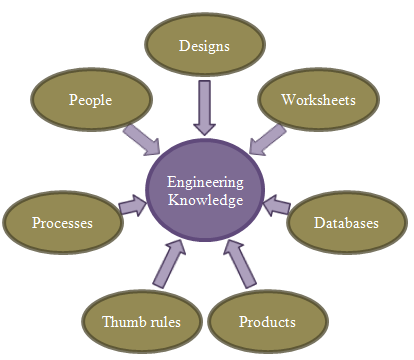 | Figure 1. Various forms of engineering Knowledge |
2. Review Procedure
- The available research on KBE briefs the theoretical groundwork even though it originates from different perspectives. However, a consolidated view of KBE is still lacking as it is the most critical to understand. The main objective of this paper is to brief KBE by selecting, classifying and reviewing the literature available at present. Later, how it can be extended to web-oriented parametric modeling will be evaluated.First the selection of the literature has been done through internet search using the keywords like Knowledge Based Engineering, Knowledge Based Design, Knowledge Based System, Intelligent Engineering System, Expert Engineering, Design Automation, Smart Engineering, Automatic Engineering, Rapid Engineering System, Reuse Engineering, Engineering Knowledge Management and Quick Engineering. The literature with engineering background was filtered for further evaluation.Internet search process was again carried out on the filtered literature with the help of their references. But the filtered papers that are cited at least one time are only considered for this stage of the search. The second level of selection of the literature was performed purely based on the topic’s relevance to the engineering domain. The filtering process was done as in the first level for obtaining the literature on CAD based modeling domain. A round of refining the literature for removing the duplicate work that is available through the conferences and journals was done for achieving the vital literature. The selection and filtration process was illustrated in the Fig. 2.
 | Figure 2. Flowchart of selection and filtration of the literature |
3. Notion of KBE
- The application of KBS to the domains of manufacturing design and production can be expressed as Knowledge Based Engineering. KBE is a system that can accumulate the existing information in the growth of the product and makes it available to reuse. The early adopter of software engineering techniques in KBS is CAD. KBE has proven its effectiveness in building CAD models where both product and process information are accessible to the designer [20-22]. KBE integrates object oriented rule based technologies with CAD and other traditional engineering software tools. On the other hand, CAD developed a tendency to drive KBE to push past their current limits. The aspects of KBE change depending upon the perspective of engineering. Depending on this perspective, KBE absorbs wider skill set from modeling to programming and even artificial intelligence [18]. In the recent development of business to business type in electronic commerce KBE attracted the focus light of researchers for further development. The inventor of World Wide Web Sir Tim Berners Lee’s vision is to develop the next generation of internet called Semantic Web, enabling the potentiality for KBE for collaborative design to meet the customer requirements [147].The need of the KBE is because of volatile, insecure, user unfriendly, disorganized present day market. Apart from the need, KBE is speedy, skilled, innovative and error-proof, these features are vital to the today’s market. On the other hand, KBE has the ability to improve the collaborative design through knowledge management and as a result automation, maintenance and re-use techniques are further advanced. With these gains, KBE extended the range to Product Lifecycle Management (PLM) and Multidisciplinary design optimization. The scope of KBE comprises design, Computer Aided Engineering (CAE), manufacturing and support fields.For nearly 20 years, KBE has been used in challenging design and engineering problems, mainly in automotive, civil engineering, aerospace industries. In the beginning, KBE approach has a successful, long running and high productive application for Boeing Company in generating geometry of stringer clips [4]. However, no one realized the early promise of KBE in practice in those 20 years, since fully functioned KBE was missing even in the aerospace world where it has its high impact. Later, the companies such as ICAD, Wisdom systems encouraged the research and developed the special purpose AI hardware such as Symbolics Lisp machines. But extremely high cost hardware became a barrier for widespread of the technology [4]. Further, these developed systems geared towards expert systems. Later, with the support of independent software vendors KBE came down to approachable cost [62]. With the advancements of fast and inexpensive computer memory KBE systems became as a commodity item. Angelo et al. [75] published the potentialities of knowledge‐based engineering (KBE) methods in new product development by estimating the business value produced by a tool which combines the engineering groups of a large aerospace company. In the recent decade, World Wide Web with the association of HTML (HyperText Markup Language), XML (Extensible Markup Language), X3D (XML for 3D Models), KBE evolved as complementary to the traditional CAD systems [4]. A simple KBS is illustrated in Fig. 3.
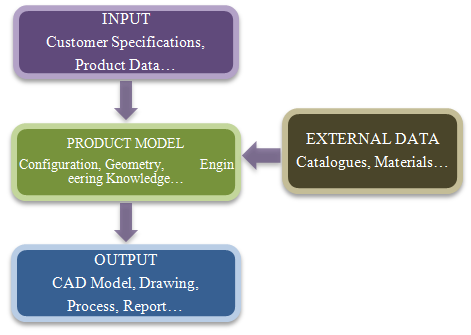 | Figure 3. Knowledge Based Engineering (KBE) System |
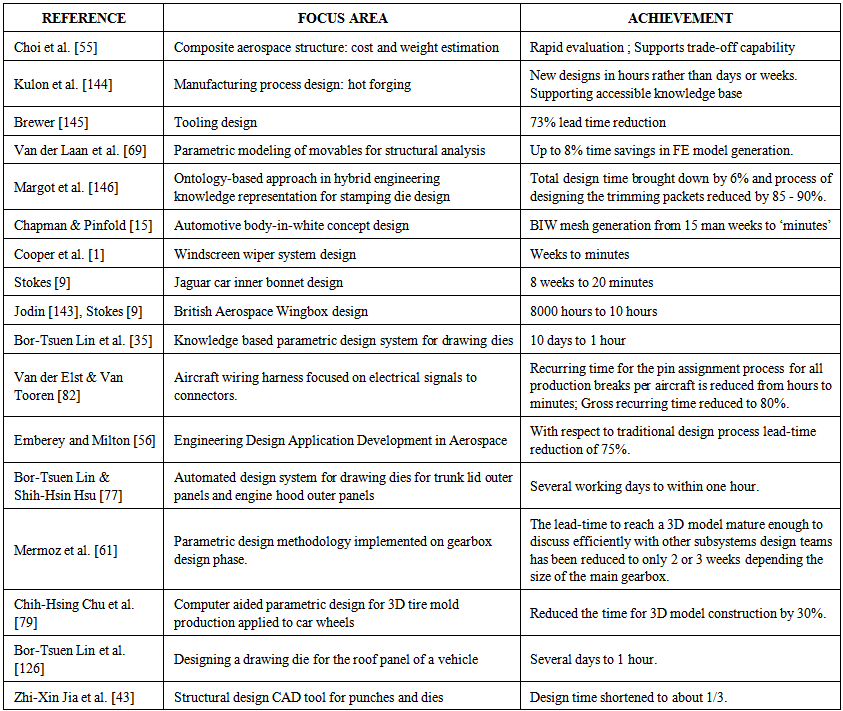 | Table 1. Results of limited number of KBE projects |
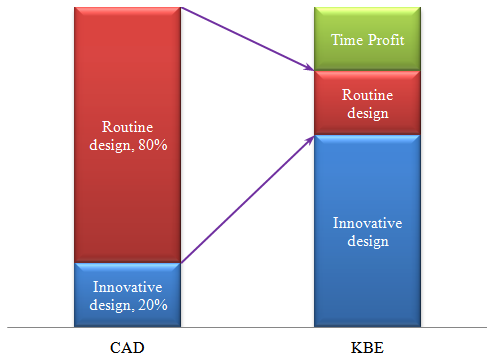 | Figure 4. Design time allocation by KBE and CAD [19] |
|
3.1. Recent Development of KBE Methodologies
- It has been observed that the maturity of KBE application concerns the requirements to identify, capture, structure, formalize and implementing the knowledge. But KBE platforms are supporting only the implementation but not KBE development process. For managing, safeguarding and upgrading the knowledge for development and maintenance of KBE system, a robust methodology needs to be associated. MOKA (Methodology and tools Oriented to Knowledge based Applications) is one of the best example for such concrete methodologies proposes solutions which focuses on capturing, structuring, formalization and implementation [9]. MOKA is a European research project that has been developed to serve as an international standard for KBE system development [64, 66]. MOKA can be treated as a bridge between raw knowledge and KBE platform and it is the widely used methodology in automobile and aerospace industries. MOKA can be used to decompose and stock up the knowledge that can be linked to prearranged network of a problem domain to which users from various perspectives can relate. MOKA can present a framework for capturing and representing the knowledge. Developing lifecycle of KBE according to MOKA is given in Fig. 5.
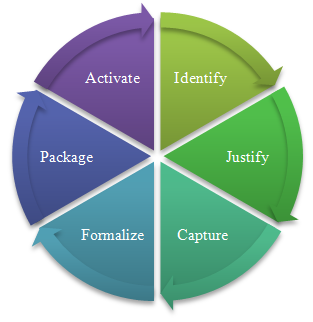 | Figure 5. KBE developing lifecycle according to MOKA [9] |
 | Figure 6. Informal model of MOKA methodology [19] |
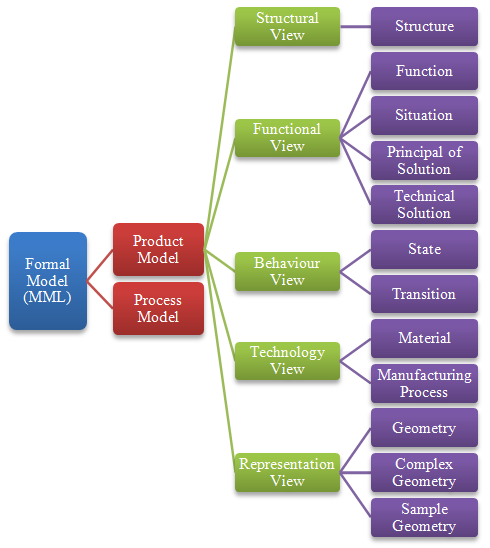 | Figure 7. Formal model of MOKA methodology [19] |
3.2. Approaches Addressing KBE Issues
- Along with methodologies, few approaches have pushed KBE to higher levels. These approaches are discussed below.
3.2.1. Parametric Modeling with KBE
- With the pioneering work of Requicha and Voelcker the solid modeling laid its foundation in 1970s [76]. Since then, the researchers turned their focus on developing the modeling techniques. In this process, advanced parametric modeling was first introduced in 1980s and it has become the new paradigm for mechanical CAD designs. But Robert Stiles [89] argues that the real origin of parametric modeling was a few decades earlier. The modeling and designing of a product in parametric modeling approach is dimension driven and which is built on set of mathematical equations to facilitate automatic re-use of existing design process based on the results of engineering analysis [85]. In parametric modeling approach, the parameters can be changed by the operator as needed to generate the preferred part by making use of history-based method which keeps the record of how the model was generated [81]. When the operator changes parameters in the model and regenerates the part, the program repeats the operations from the history, using the new parameters, to create the new solid. Parametric design can be treated as a powerful, easy, proficient expert method for consistent product design [135].In 1989, the development and modification of parametric solid models by graphical interaction was discussed by Maarten and Van [84]. Their objective was to define the relationship of geometric properties of constructive solid geometry primitive. With the inspiration of the above research work Suzuki et al. [86] detailed the importance of geometric constraints and reasoning in CAD systems in 1990. Soon, the research on parametric modeling gradually focused on 3D models. In 1993, Pérez [87] projected a methodology to allow the designer to build a geometric model by dimensional changes that are propagated to the finite element model in 3D constraint based finite element modeler. Later, with the association of artificial intelligence, parametric modeling approach elevated CAD to a new level. A lot of research on parametric modeling systems has been proposed for different expert systems to enhance the design effectiveness. Taking the advantage of pre-built knowledge base Lin and Hsu [77] and Bor-Tsuen Lin et al. [35] proposed an automated design system for drawing dies. Similarly a semi automatic parametric gating design system for die-casting die was developed by Wu et al. [78]. Myung and Han [81] proposed a framework which parametrically models the machine tool as the commercial CAD systems cannot handle the parametric design of assembly models. This system consists of commercial CAD software with API programming and expert system shell. Recently Gui and Guan [88] has used parametric modeling in CATIA software for constructing 3D model of a UAV (Unmanned Aerial Vehicle) airframe and avoided the disadvantages of 3D modeling approach such as high time consuming, low efficient, and poor interaction. Carlos [137] presented a parametric design methodology called Design Procedures (DP) that can overcome topological and geometrical limitations of traditional parametric models. Several examples of parametric models directly managed by the CAD construction tree are presented in Refs. [29, 30, 35, 69, 73, 78-81].As Du Yao et al. [135] presented in their paper parametric modeling can be achieved in two approaches.
3.2.1.1. Parametric Modification Method Modeling
- This is an approach where the parametric modeling can be done with the help of model library. Model library usually consists of prebuilt models generated by user in advance. This approach can access the models in library at any time of the execution and can modify the size of the model with the specified parameters to regenerate the new model that matches the required dimensions. This approach is suitable where the model to be formed is complex, standardized and consists of less variable parameters as the approach demands less programming skills.
3.2.1.2. Parametric Modeling Fully by Program
- This is a complete program control approach where the user can straightaway develop the program to produce the parametric model based on the needs. This is the flexible and suitable approach for modeling without the support of model library. However, as the approach demands high level of programming skills it may be suitable where the model is simple but consists of high number of variables.The early CAD systems are often criticized for their static modeling technique such as constructive solid geometry (CSG), boundary representations (Breps), or a hybrid of the two [91]. However, parametric design systems such as variants programming, history-based constraint modeling, variational design, rule-based variants, and parametric feature-based design substituted the deficit of the conventional CAD systems by enabling dynamic modeling and modification [92, 93]. In 1988, the first commercially successful parametric software, Pro/ENGINEER with 3D geometry capabilities was released into market by the former mathematics Professor Samuel Geisberg, the founder of PTC (Parametric Technology Corporation). During the releasing press meet, Samuel Geisberg expected that parametric modeling approach not only enable the designer to a variety of designs but also allows a choice to be made later in the design [90]. In 1993, French software Dassault Systèmes S.A. released its first CAD software CATIA V4 with parametric features. Later, Autodesk Inc. released Auto CAD2010 with parametric functionality, and announced in the press release as “a groundbreaking new capability”. Later, on parametric modeling approach went through the scripting interfaces of CAD software packages allowing the designers to write code to automate parts of the software. Currently, parametric modeling is no long the exclusive domain of overtly parametric tools like CATIA and Pro/ENGINEER. Parametric modeling capability drive into other CAD softwares such as Creo Parametric, NX, CATIA V5, SolidWorks, Solid Edge, Inventor, IronCAD.Based on the review, the observations of parametric modeling system are: Parametric modeling not only provides appreciated experience about the final product’s proportions and form but also presents how the design is modified. With the involvement of KBE, parametric modeling approach proposes enhanced integration with manufacturing practice and assists to reduce the product development time. Parametric modeling offers better details of the model for analysis and prototyping. However, when developing the parametric model as the design factors are not fully considered, it is unrealistic that this approach can replace people. On the other side, parameterization is possible on the standards, common and series products.
3.2.2. Function Based Modeling through KBE
- In general the reason for designing a product is to meet a certain function. But the objective can be attained easily with some additional support. Unfortunately, this extra additional support is making the design process more complex [96]. The conventional CAD systems cannot carry out automatic modeling based on the given specifications as they are not built with AI to perform reasoning and to make decisions by itself. In practice, these activities are performed by the designers to fulfill the requirements. Recent advances in the field of CAD systems have greatly increased the influence of AI on the modeling phase of the design of the product by encompass human knowledge [94, 95]. Function oriented design has become an active area of research for the past decade. The intention of functional design is to present computer aided tools to connect design functions with the physical embodiments used to recognize the function [98]. In the early stage of the development of functional design approach, Chakrabarti et al. [99] pointed that knowledge of functionality is required for design, modification, comparison, evaluation of the process. In reality the definition of function given by many researchers is observed to be diverse and contradictory. However, designers agree that there is tight coupling between function and behavior. Function is what the design is going to do while the behavior is how the expected result is attained from design. The most common form of knowledge representation in functional design is rules, frames, objects and constraints. In 1996, Li et al. [100] applied rule based paradigm for automating the computational synthesis of conceptual design of mechanism. A frame based structure was used to model the kitchen appliances by Tong and Gomory [101]. Gelsey et al. [102] developed a conceptual design of supersonic aircraft using constraint based model in 1998. An easily modify and highly flexible object oriented architecture was proposed by Akagi et al. [154] for developing a sustainable functional design process by considering the objects as elements. Zhang et al. [103] proposed an integrated knowledge method that unites rule-based and object-oriented representation methods to stand for functions and functional related design characteristics in an intelligent design environment.Andrews et al. [97] proposed the concept of design reuse in CAD systems to facilitate quick design by using already-available product’s design process. Tor et al. [104, 105] has drastically reduced the time and effort needed in configuring industrial robot by make using of behavior-driven, function-environment-structure (B-FES) modeling framework. Xu et al. [106] proposed a function-based design synthesis approach to support design reuse framework by using functional-based product information model and multiple objective optimization model for developing intelligent product structure.
3.2.3. Web-Based Approach in Favor of KBE
- With the recent development of the Web-based technologies, many new approaches have been proposed to execute advanced product design systems. Web-based approach towards KBE has become the center of attraction for research as web technologies offer an essential path for information sharing and exchange [107]. In the research of Chun-Hsien Chen et al. [49], Tu et al. [108], Ming-Chyuan Lin et al. [110], Xie et al. [109] Web-based approaches are used to deal with the changing customer requirements as internet enhances the interactive levels among designers and customers. Web-based approaches not only consider the customer needs but also enhance the conventional design process. In the research paper, Kulon et al. [113] summarized Web-based KBE system to merge hot-forging design processes to a single framework for capturing the knowledge and experience of the design engineers. In addition, global collaborative design approach can be implemented using Web-based approach. For example, Ming-Chyuan Lin et al. [110] has developed an interactive interface for considering customer needs in the early phase of product development, Qin et al. [111] proposed a quick Web-based conceptual design system for examining and modifying the product design over internet, Xie et al. [114] developed a Web-based integrated product design platform for concurrent design and manufacturing the customized products. Moreover, web can be integrated with management technologies for keeping an eye on the design process and the working systems [112].Apart from the design perspective, internet can provide product visualization for better understanding the product. For visualization, the product data is categorized into text forms, 2D engineering drawings, 3D solid models, animations, audio, and video. With the richness of HTML technology, the product data such as text, audio, video and animation can be handled. The other product data such as 2D engineering drawings, 3D solid models can be visualized with the support of web enabled data formats like VRML (Virtual Reality Modeling Language), DWF(X) (Design Web Format) etc. But 3D solid model can be realized by integrating the 3D entities of solid with VRML through STEP (Standard for the Exchange of Product model data) files.Apart from the above advantages, web-based KBE approach is encountered with some disadvantages such as the knowledge available through internet is not surely reusable as it is not standardized. But it can be resolved by making use of STEP approach as it provides standardized knowledge.
3.2.4. Ontology Based KBE
- Ontology is a precise requirement of conceptualization and illustrates a set of representational primitives with which a domain of knowledge is modeled [151, 152]. Ontology provides knowledge sharing and reuse by instituting a precise concurrence of objects and relations within a particular domain of conversation [153]. Ontology is machine readable without being too cryptic for human understanding [152]. By establishing a common language for use and interpretation of information, ontologies allow for efficient and organized exchange and reuse of knowledge. Today, one of the fundamental problems to a designer is the exchange of product information across various applications. According to Cari et al. [116] ontology is a philosophical theory about the nature of existence. Ontology based KBE approach facilities the exchange and reuse of design process while incorporating the additional knowledge [115]. This approach is applicable where the complexity in relationship between concept and knowledge exists. Using this approach searching for relevant knowledge is simple. In engineering activities semantic retrieval of engineering domain knowledge is treated as critical, but that was overcome by Xutang et al. [117] using ontology based approach in 2013. Ontology is a well prepared system that covers the progress, objects and attributes of the domain as well as their pertinent complex links [140]. Margot et al. [146] developed a KBE tool aimed at SMEs to reduce the total design time of stamping die with ontology based approach in hybrid engineering. After executing the tool, the total design time was brought down by 6% and the process for designing the trimming packets reduced by 85 to 90%. Moreover, ontology based approach offer the opportunity for progressive automation of processes in the industry. With this approach, integrating the shapeless knowledge for better conceptualization is possible for the complex designs [138]. According to Guarino et al. [139] ontology based approach is a concept that allows the designers to model and represent a particular domain in terms of axiomatic definitions and taxonomic structures. In the recent researches, it has been observed that ontology-based approach can help in attaining the common language for capturing the domain knowledge and it is proven that it is an advanced paradigm over the recent years [141]. By facilitating the exchange of knowledge in the process of design, Witherell et al. [142] presented the capability of ontology approach in representing application-based knowledge. However, ontology-based KBE approach has disadvantages in organizing the knowledge of product which is not proper for varying manufacturing environment.
3.2.5. Case-Based KBE
- Case-based Reasoning (CBR) approach provides the methodology to solve the new problem by making use of the previously solved similar problem’s solution, by reusing the knowledge of the previous situation [118, 119]. Just like as database stores the data, case-base stores the cases with indexed problem solutions. A case is an experience which represents the conceptual knowledge [134]. CBR consists of four processes: Retrieving the similar previous case from case-base; Reusing the previous similar case solution to the new case; Updating the retrieved solution with new case; Storing the newly updated solution as a new case [128]. A general CBR execution cycle is shown in Fig. 8.
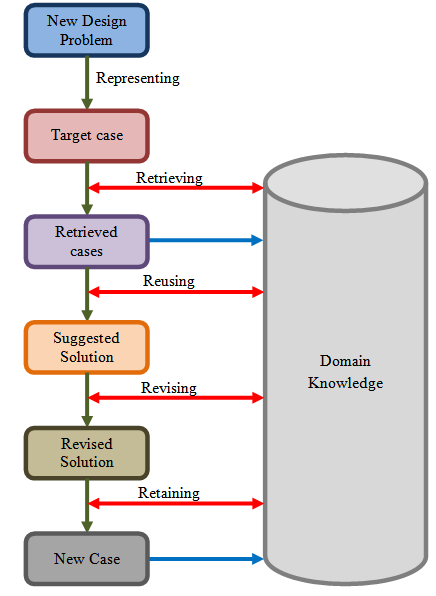 | Figure 8. CBR Execution cycle [120] |
4. Discussion, Limitations, Future trends of KBE
- With the advent of the internet and continuous development of software and hardware, KBE approaches are enhancing their capabilities in capturing, reusing the knowledge across time and space. But still, the designers are not able meet the customer’s desire because of many reasons. One of them is the knowledge management (KM) problem. KM is developed for capture and reuse of the domain knowledge to integrate the traditional engineering software with knowledge based applications. The reluctance among traditional CAD tool vendors is slowing down the evolution of KAD (knowledge-aided design) as they fear of losing the market. But recently, few vendors are making the progress towards the development of KAD and that should be encouraged in large scale. Whereas, the lack of robust knowledge acquisition system is still missing even after the immense research and it has become one more hurdle for the progress of KBE system. There is also a need in building the automatic knowledge acquisition tool. The mass collaborative product development approach demands faster knowledge accessing system but there is no dependable knowledge base available as the knowledge through the internet is not standardized. But according to recent studies, this can be handled with the rise of wikis. A wiki is a database which allows the users to interact and share the information through web pages. The group of designers can create the standardized knowledge base as global knowledge repository with the help of wiki. It is observed that KBE system became revolution with the inclusive of AI. But the compilers and editors for programming the KBE tasks are still complex for the designer as they are not professional programmers. This shortfall demands immense research on easy programming for compiling the KBE system. Additionally, research need to be done to make the software and hardware cheaper for KBE system as the available are affordable for the big companies only. Another shortfall with the present KBE system approach is from its methodologies. Even after the development of advanced MOKA and its enriched approaches, preparing the formal models is a complex task. This should be automated as an application for easy translation. Based on the review, it is observed that this area of research is still underdeveloped. Another shortfall with the present KBE system approach is it is getting developed as black-box application. In black box application, some output with some input will be produced but nobody knows what happens in between. This situation leads to the problem of transferring the knowledge to new engineer in the department as no one knows what exactly is going on in the process.Web-based KBE approach is one of the most attractive areas for the researchers in the recent years. With the web-based KBE approach, the designers need to collaboratively design the product in dynamic information transfer environment. But updating the information dynamically is a critical issue. Web servers must also be robust along with the designers approach as entire communication will be handled by the servers only. However, recent advances in web technology are meeting this need but they cannot support the knowledge repository. So, dedicated servers for sharing the knowledge are developed in recent years and such servers are called agents. The main objective of this agent technology server is to share the knowledge dynamically to support collaborative design system in a distributed environment on behalf of design development team. In this context, agent is software that supports the communication dynamically as soon as new information is generated. The critical objective of this technology is to share the real-time product information to make the collaborative design process in a more effective way. So, the scope for research in this area is enormous.Case-based KBE application is the other research area where the researchers can focus. It seems that development of application is meant only for single or related purpose but it should support the other purposes by making it a custom development process. This notion is verified in this review and it is observed that most of the methodologies are focused on a single or related purpose. The impact of existing methodology seems to be limited in practice. This is the area where the researchers need to focus as the scenario is giving the impression that the knowledge loss may follow due to poor modeling of the application.Collaboration of KBE approaches discussed in this paper is the other interesting research area where the authors are looking for. Today’s competitive market made the customer the decision maker about the fate of the product. If any product is able to sustain in the present turbulent market, it implies that it is serving the customer requirements better than the competitors. So, the involvement of the customer into design process will lead to better design. Web-based KBE approach gives the environment for the customer to be in the process of design. As the customer does not have the design knowledge, the design process should enable the function-based search system for better presenting and understanding the customer requirements. So, research can be carried out with the involvement of customer in design process, based on the functionality through web-based technology. The authors are looking forward to carrying out the research to develop a web-oriented function based parametric modeling system using KBE.
5. Disclaimer
- The commercial software systems identified in this paper doesn’t imply the recommendation or endorsement by the author nor does it imply that they necessarily the best available for the purpose.
 Abstract
Abstract Reference
Reference Full-Text PDF
Full-Text PDF Full-text HTML
Full-text HTML